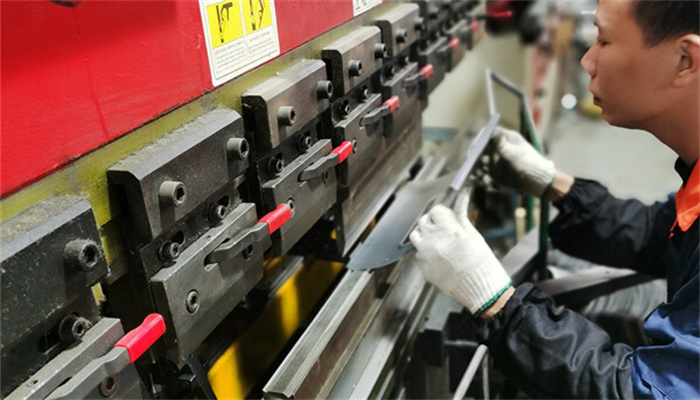
Custom sheet metal fabrication is a flexible and precise metal processing method that can produce high-quality sheet metal parts that meet the specific needs of customers through a series of precision processing steps. Quality control can significantly improve the quality and efficiency of sheet metal manufacturing and meet the needs of various industries for customized sheet metal parts.
What is Custom Sheet Metal Fabrication?
Custom sheet metal fabrication is a metal fabrication process that involves processing sheet metal into parts or products with specific shapes and sizes through a series of processing steps such as cutting, bending, welding, and assembly. This process is usually based on the specific needs of the customer. Custom sheet metal fabrication is used in a variety of industries, such as automotive, aerospace, electronics, appliances, construction, and industrial equipment.
Common Processes for Custom Sheet Metal Fabrication
1. Disassemble Product Drawings
Disassembling a product drawing is an initial step in custom sheet metal fabrication. It involves breaking down the overall design into its individual components to understand how each part will fit and function in the final product.
Detailed analysis: Engineers analyze drawings to determine the dimensions, tolerances, and materials required for each component.
Bill of Materials (BOM): Create a BOM to list all necessary materials and components .
Process Planning: Develop a step-by-step manufacturing plan including : material specifications, processing steps, tools and equipment.
2. Laser Cutting
Laser cutting uses a high-powered laser to cut precise shapes from sheet metal. Laser cutting is suitable for sheet metal processing up to 6mm thick.
Precision and Accuracy: Laser cutting can achieve a high degree of precision, making it ideal for intricate designs.
Material Efficiency: Minimize waste by using the exact amount of material required for each part.
Versatilidad: Works with a variety of materials including stainless steel, aluminum and carbon steel.

3. Bending
Bending involves shaping sheet metal into the desired shape using a press brake or other bending tools.
Angle Accuracy: Modern bending machines are equipped with CNC controls to ensure precise bending angles.
Tooling: Selecting the proper tooling is critical to avoiding material deformation and achieving consistent bends.
Springback compensation: Engineers account for material springback, the tendency of metal to partially return to its original shape after bending.

4. Welding
Welding is the process of joining metal parts together using heat and pressure. Depending on the application, various welding techniques are used, such as TIG, MIG, and spot welding.
Joint integrity: Ensure joints are strong and durable and can withstand mechanical stress.
Deformation Control: Use techniques such as staggered welding and clamping to minimize deformation and maintain dimensional accuracy.
Material compatibility: Correctly select welding techniques based on material properties to prevent problems such as cracking and warping.

5. Grinding and Deburring
Grinding and deburring involves smoothing rough edges and surfaces after cutting and welding.
Surface Smoothness: Achieve a smooth surface finish by removing burrs and sharp edges, enhancing the appearance and safety of parts.
Precision Grinding: Maintain dimensional accuracy and surface flatness using precision grinding tools.
This is done using methods such as manual deburring, tumbling and automatic deburring machines .
6. Surface Finishing
Surface treatment processes can enhance the appearance, durability and corrosion resistance of sheet metal parts.
Painting and powder coating: Provides a protective and aesthetic coating to parts.
Plating: Processes such as galvanizing, anodizing, and electroplating add a protective layer to prevent corrosion.
Surface preparation: Use techniques such as sandblasting and polishing to achieve the desired surface texture and finish.
7. Assembly
Select the appropriate assembly method to assemble the components into the final product.
Precision Fit: Ensure all parts fit correctly and maintain specified tolerances.
Fastening Methods: Components are secured using appropriate fastening techniques such as riveting, bolting, and welding.
Functional Testing: Testing is performed to ensure that the assembled product meets functional and performance requirements.
How to improve sheet metal manufacturing quality?
Strategies to improve sheet metal manufacturing accuracy, efficiency and quality control:
- Strict quality control
Process Inspection: Inspection is performed at various stages of the manufacturing process to detect defects as early as possible.
Final Inspection: Finished products are thoroughly inspected using precise testing tools to ensure they meet specifications.
- Continuous improvement practices
Lean Manufacturing: Using lean principles to eliminate waste, improve workflows, and increase efficiency.
Six Sigma: Implement Six Sigma methodology to reduce variability and improve quality.
- Supplier quality management
Reliable Suppliers: Work with suppliers who provide high-quality raw materials and components.
Supplier Audits: Audit suppliers regularly to ensure they meet your quality standards.
- Customer feedback and continuous learning
Feedback loop: Collect and analyze customer feedback to identify areas for improvement.
Benchmarking: Compare performance to industry standards and competitors to identify best practices and areas for improvement.
Conclusion
Custom sheet metal fabrication is a complex manufacturing process that involves multiple stages, from disassembly of product drawings to assembly and quality control. By utilizing advanced technology, maintaining strict quality control, investing in modern equipment, and developing a skilled workforce, manufacturers can significantly improve the quality of your sheet metal products.
Tirapid’s ongoing continuous improvement practices further ensure that products meet the highest standards of precision and durability, ultimately increasing customer satisfaction and competitive advantage in the market.
